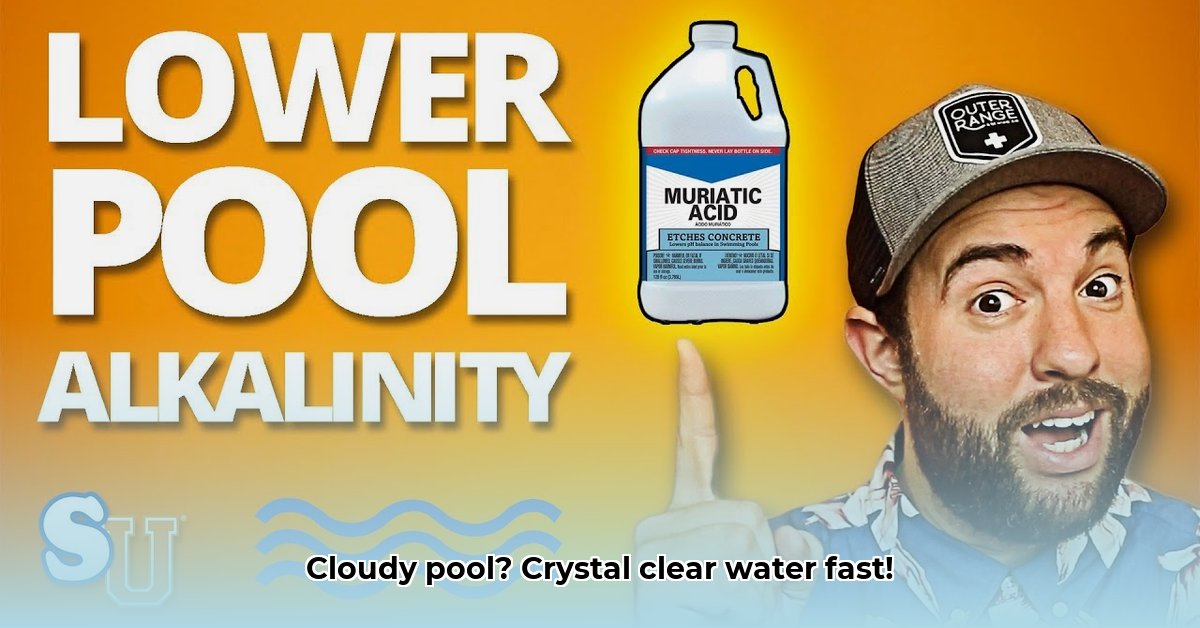High alkalinity can turn your sparkling pool into a cloudy mess, hindering chlorine’s effectiveness and potentially causing scaling and irritation. This comprehensive guide provides a step-by-step approach to reducing high alkalinity and maintaining balanced pool chemistry for a pristine swimming experience.
Decoding Alkalinity and Its Impact on Your Pool
Total alkalinity (TA) acts as a buffer, stabilizing your pool’s pH against fluctuations. However, excessively high TA (above 120 ppm) can disrupt this delicate balance. This can lead to a cascade of problems:
- Cloudy Water: High alkalinity interferes with the water’s clarity, creating a murky and uninviting appearance.
- Scaling: Elevated TA can cause calcium and other minerals to precipitate out of solution, forming unsightly deposits on pool surfaces and equipment.
- Reduced Chlorine Effectiveness: High alkalinity neutralizes chlorine, diminishing its sanitizing power and increasing the risk of algae and bacteria growth.
- Skin and Eye Irritation: Imbalanced water chemistry, including high alkalinity, can irritate swimmers’ skin and eyes.
Effective Methods for Lowering Alkalinity
Two primary methods effectively reduce high alkalinity: muriatic acid and sodium bisulfate (dry acid). While both achieve the same goal, they differ in potency and handling requirements. Choosing the right method depends on your comfort level and experience with pool chemicals.
Method 1: Muriatic Acid (The Powerful Approach)
Muriatic acid (hydrochloric acid) is a potent solution for quickly lowering alkalinity. However, its corrosive nature demands careful handling and strict adherence to safety precautions:
-
Gear Up for Safety: Before handling muriatic acid, equip yourself with essential safety gear:
- Chemical-Resistant Gloves: Protect your hands from the acid’s corrosive effects.
- Safety Goggles: Shield your eyes from splashes and fumes.
- Protective Clothing: Cover exposed skin to minimize contact with the acid.
- Respiratory Protection: A respirator or mask can prevent inhalation of harmful fumes, especially in poorly ventilated areas.
-
Precise Measurement and Dilution: Accurate measurement is crucial to avoid over-treatment.
- Test Your Water: Use a reliable test kit (liquid or digital) to determine your pool’s current TA and pH.
- Calculate the Dosage: Utilize a pool calculator (many are available online) to determine the precise amount of muriatic acid needed based on your pool’s volume and TA reading.
- Dilute the Acid: Always add acid to water, never the reverse. Slowly pour the measured amount of muriatic acid into a bucket filled with water, stirring gently with a non-metallic utensil.
-
Gradual Addition and Circulation:
- Pour Slowly: Add the diluted acid solution gradually to the deep end of your pool near a return jet, ensuring even distribution. Avoid splashing.
- Run the Pump: Circulate the water for at least 4-6 hours, or as recommended by the acid manufacturer, to distribute the acid evenly.
-
Retest and Adjust:
- Check TA and pH: After the circulation period, retest your pool water. If TA remains high, repeat the process with a smaller dose.
- Adjust pH: Muriatic acid lowers both TA and pH. If your pH falls below 7.2, raise it using a pH increaser or aeration techniques (discussed below).
Method 2: Sodium Bisulfate (The Gentler Option)
Sodium bisulfate, commonly known as dry acid, offers a safer alternative to muriatic acid. Although less potent, it effectively reduces alkalinity without the same corrosive risks.
-
Safety Measures: While generally safer than muriatic acid, sodium bisulfate still requires precautions:
- Gloves and Eye Protection: Wear gloves and safety goggles to prevent skin and eye irritation.
-
Dosage Calculation and Dissolution:
- Test and Calculate: Determine the required dosage using a pool calculator and your pool’s TA reading.
- Dissolve Completely: Dissolve the measured amount of sodium bisulfate in a bucket of water, stirring until all granules are fully dissolved. This prevents undissolved granules from settling on the pool bottom and potentially damaging the surface.
-
Application and Circulation:
- Even Distribution: Pour the dissolved solution evenly around the pool’s perimeter.
- Run the Pump: Circulate the water for at least 4–6 hours to ensure uniform distribution.
-
Monitoring and Adjustment:
- Retest: After circulation, check your pool’s TA and pH. Repeat the treatment if necessary.
- pH Adjustment: Similar to muriatic acid, sodium bisulfate can lower pH. Raise it if needed using a pH increaser or aeration.
Balancing pH after Alkalinity Reduction
Both muriatic acid and sodium bisulfate lower pH along with alkalinity. If your pH drops below 7.2, raise it back to the ideal range (7.2-7.8) without affecting the newly adjusted alkalinity. Aeration is the most effective method for this:
- Increase Water Circulation: Pointing return jets upwards or running water features (waterfalls, fountains) agitates the water’s surface, promoting the release of carbon dioxide and raising pH.
- Manual Aeration: Using a pool brush or simply splashing around can also contribute to aeration, although less effectively than dedicated features.
Maintaining Balanced Pool Chemistry: A Proactive Approach
Consistent monitoring and proactive maintenance are essential for preventing future alkalinity imbalances:
- Regular Testing: Test your pool water weekly for TA, pH, and other essential parameters. This helps you identify and address imbalances early.
- Balanced Chemical Application: Always follow product instructions carefully and avoid overusing chemicals.
- Filter Maintenance: Regular backwashing or cleaning of your pool filter ensures efficient removal of debris and contributes to balanced water chemistry.
- Water Source Awareness: Test the alkalinity of your fill water. If your source water has high alkalinity, you may need to adjust your pool chemistry more frequently.
By understanding the dynamics of alkalinity and employing these strategies, you can maintain crystal-clear, balanced pool water for a healthy and enjoyable swimming experience. For persistent issues or if you’re uncomfortable handling pool chemicals, consult a qualified pool professional.
- Why Does CoD Always Fail to Launch? Understanding the Core Issues - December 25, 2025
- Why Call of Duty Not Launching on Steam? Common Technical Reasons - December 24, 2025
- Call of Duty Not Launching Steam? Get Your Game Running Again - December 23, 2025





